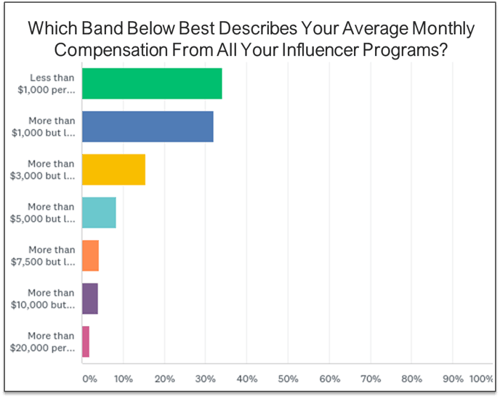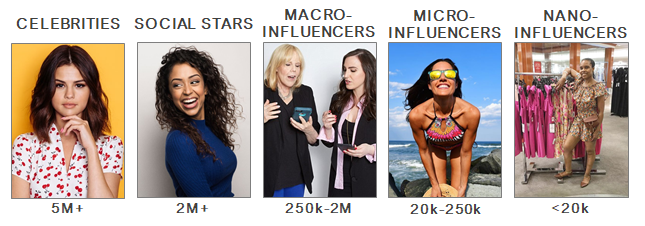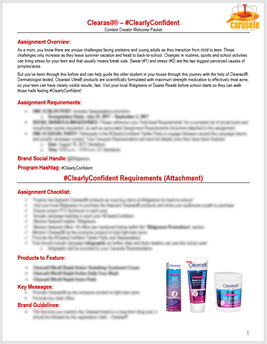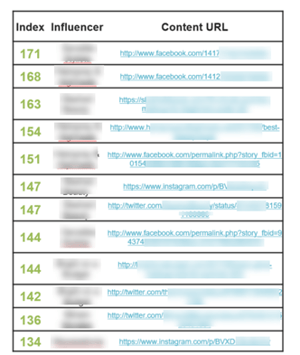In a world where marketers are doing influencer marketing "because everyone else is doing it so I should be to," things can easily get messy. The industry has vastly expanded over the past ten years, and influencer marketing isn't as black and white as it once was. Now, there are different types of influencers, fake follower scandals, issues with measurement, and more.
After running over 150 influencer marketing campaigns since launching in 2015, we've put together a checklist of nine steps we recommend taking in order to achieve a successful influencer marketing campaign. While this blog post only covers high-level insights into some of those steps, you can download the full checklist here to learn some of our secrets to success.
Without further ado, let's get started with our first step!
Nine Steps to Influencer Marketing Success
Step One: Set Your Business Goals
Before you begin any type of implementation, it’s extremely important that you know what you’re objectives are for influencer marketing. Too often do marketers jump on the bandwagon of a new tactic before figuring out what their strategy should be. But, if you take the time to answer the five questions we’ve outlined below, you should be on the right path towards success.
- What product/service/event do you want the content to support?
- What does your target audience look like and on which social media channels do they spend the majority of their time?
- Describe success. “At the end of the campaign, we’ll be happy if…”
- What Key Performance Indicators might help you optimize during the campaign?
- How will you measure success and Return on Investment when the campaign concludes?
Pro Tip: Don’t try to do too much with a single program. Content that doesn’t feel natural won’t perform, and fragmenting your strategy by trying to meet too many objectives is never a good idea!
Step Two: Identify Your Budget
Let’s face it, influencer marketing isn’t getting any cheaper as demand continues to increase. Not only do influencer fees continue to rise, but as the space evolves, the level of effort required to run an impactful campaign with important brand protections in place is on the rise as well. A key question to answer when it comes to budgeting is whether you’ll execute in-house or outsource campaign management.

AGENCY MANAGED INFLUENCER CAMPAIGNS
For those planning to outsource influencer campaigns to an agency, your first step is to determine how much budget you’re going to invest on an annual basis. If you’re new to the space or still trying to determine what the right investment should look like, the chart below shows results from a survey conducted by The Association of National Advertisers asking, “How much do you spend annually on influencer marketing?”
INTERNALLY MANAGED INFLUENCER CAMPAIGNS
For those with in-house influencer marketing teams, you’ll need to allocate budget across four areas:
- Staff Members
- Media Fees
- Third-Party Tools
- Influencer Fees
When determining the value of each of these components, make sure you have the right balance between your staff and your automation tools. We’ve found many internal teams are automating too much in an effort to cut back on costs, which is ultimately costing them long-term.
COMPENSATING YOUR INFLUENCERS
Last year, we conducted a survey with TapInfluence of over 790 influencers in an effort to help brands and influencers work better together. Within this survey, we found that some brands are still offering free product as a form of compensation. In the competitive landscape the influencer marketing industry has evolved into, that tactic doesn’t fly with many influencers anymore. Additionally, 53% of influencers listed low compensation as their biggest challenge. While there are many factors to consider when selecting your influencers (which we’ll elaborate on in the following section), take into consideration the influencers answers from the chart below. Take note that on average, these influencers work 1-4 campaigns in a typical month.
Watch Out! We see brands making two major mistakes in this step: (1) Undervaluing the level of work that goes into the ask, or (2) Making an initial offer that far exceeds the influencer’s value. One burns bridges, the other results in negative ROI in the short-term and overall marketplace inflation in the long term.

Pro Tip: When calculating an influencer’s payment, consider what it would cost you to get similar results (reach, engagement, etc.) via a premium digital media placement in your category/industry and what it would cost to outsource the work you’re asking them to do. Your initial offer should land in the middle of those two costs.
Step Three: Find the Right Influencers
When it comes to identifying the best influencers to represent your brand, there are three factors to consider. To start, we recommend that you never implement opt-in programs because you’ll lose control of who’s representing your brand. Instead, as we do at Carusele, you should take the time to hand-select and vet creators for your campaigns, and think about what type of influencer you want to partner with.
The ABC's of Influencer Selection
A - Audience Fit
Is this influencer right for this audience?
By using third-party insight data, we’re able to see who an influencer’s audience is, including demographics, location, and interests.
B - Brand Fit
Is this influencer the right fit for this brand?
Leveraging the power of IBM Watson, we identify ideal candidates based on demographics, content themes, performance history and more.
C - Content Fit
Is the content this influencer is going to produce a fit for this campaign?
Our influencer specialists personally review all of an influencers channels to determine fit, including voice, tone, look and feel, history with competitors, and authenticity
THE FIVE TYPES OF INFLUENCERS
As the industry has grown over the last 10+ years, many brands and marketers have had trouble defining influencer marketing as well as defining the different subsets of social media influencers. At Carusele, we’ve come to find that there are 5 categories of social media influencers, each providing a unique value to the brand they’re partnering with.
Step Four: Set-Up Influencer Campaign Contracts
The influencer contract is one of the most important assets in an influencer marketing campaign. There are many components to consider, and given the importance of this document it can be wise to have your contracts basic terms drafted by your legal team. At Carusele, we use what we call a Welcome Packet, combining the brand brief and the influencer contract into one document that’s customized for each influencer. Below are questions to consider as you’re developing your brand brief and a checklist of key components to include in your contract.
Questions to Consider
Let’s start with some questions you should begin to ask yourself when developing your brief in order to give the influencer everything they need. The list below is intended to inspire you to think about specific questions that will apply to your brand and your brand guidelines:
- Is it okay to have children in the content?
- Is it okay if the influencer uses any non-competitive brands in the content?
- Is it okay if the product is laying flat, or does it need to be positioned a certain way?
- Is it okay if the influencer uses a filter on top of the imagery?
- Is there a color scheme the influencer should try to match? One they should avoid?
Key Components
At Carusele, we customize every contract to include all of the influencers responsibilities & guidelines they need to adhere to, such as:
- Brand Guidelines
- Approval Requirements
- Key Messaging & Legal Disclaimers
- Assignment Requirements & Details
- Publishing Schedule
- Featured Product Information
- FTC Compliance and Disclosures
- Approved Hashtag(s)
- Content Ownership Language
- and more…
Step Five: Care About Compliance
As influencer marketing gets more attention, it’s important to familiarize yourself with the latest Federal Trade Commission (FTC) policies. Just last year the FTC settled its first lawsuit against two social media influencers for not disclosing their connections to a business and also sent out 90 “educational letters” to influencers as a reminder of their policies. The FTC has also been clear that brands have a responsibility for the influencers they engage. Below, we’ve compiled a dowbloadable cheat sheet to ensure you’re not the next brand the FTC makes an example out of.

Step Six: Monitor Performance in Real Time 
When it comes to influencer marketing, you can never “set it and forget it” – you need to develop a system to monitor your content on an ongoing basis. And while a tool can be helpful for this portion of a campaign, you can’t rely 100% on this. You’ll still need someone to physically go in and check content accuracy and compliance. Additionally, it’s also important to develop a process for identifying the top performing content in real time during the campaign, allowing you to optimize the campaign as it’s running.
We launched a new proprietary algorithm, cStack™, that evaluates every individual piece of influencer-produced content based on impressions, engagements, clicks, etc., then compares the content against one another to determine top-performing content. This includes a manual check of each piece of content to ensure it matches the brand brief, meets our content standards, and features engagements that are both real and relevant to campaign messages.
While you may not have this exact process, it’s still important to monitor your content in real time to see how each piece performs and to identify those pieces that are generating the best results.
Step Seven: Implement an Amplification Plan
Now that your content is live and you’ve had the opportunity to identify top-performing content, it’s beneficial to share that content through paid tactics designed to reach highly targeted audiences outside of the influencers organic following. It's important that you DO NOT just hit the boost button, but try one of these four ways to amplify that content to additional target audiences.
Step Eight: Measure Your Success
At the beginning of this checklist, you should have set your KPIs and business objectives, as well as ensured your entire team was in alignment about your goals. If you didn’t do this, you’re most likely scrambling to make sense of the data you’ve gathered and unable to prove your success. However, if you did this exercise properly, then check out that data.
Pro Tip: Don’t underestimate the insights you can pull from campaign content performance. Influencer campaigns are a great testing ground for creative styles and messaging.
For those of you who may have struggled to set your goals at the beginning, you’re still in luck. Our post on 25 ways to measure influencer marketing discusses the options, benefits, and limitations of a variety of measurement strategies for influencer marketing campaigns. We discuss everything from vanity metrics like impressions and engagements, to purchase indicators like conversion tracking and sales lift.
Step Nine: Continue to The Conversation
Just because the campaign has ended doesn’t mean the campaign content can’t live on. Assuming you’ve properly negotiated content licenses, you now have a library of high-quality, pre-tested, and proven creative assets, available to use. Take advantage of that and re-purpose top-performing influencer content on brand-owned channels or across other marketing materials such as billboards, ads, magazines, email, and more.
Watch Out! Don’t assume you have rights to use content just because you hired influencers to create it for a campaign. Unlike agency relationships, influencers have not signed your company MSA and are not producing “work for hire”. Many brands mistakenly believe they automatically retain the copyright for content their influencers have created. Instead, you should be able to easily negotiate a fairly unlimited license to re-use and re-purpose the content up front as part of your contract with the influencer.
Don’t feel overwhelmed by this checklist. We’re happy to help you design the right strategy for your influencer marketing programs. Fill out the form below to contact us, and a member of our team will reach out shortly.
-1.png?width=504&height=360&name=Carusele%20logo%20%C2%AE%20logo%20Color%20(2)-1.png)
.png?width=728&name=Blog%20Ads%20(4).png)
.png?width=728&name=Blog%20Ads%20(8).png)
.png?width=728&name=Blog%20Ads%20(2).png)
